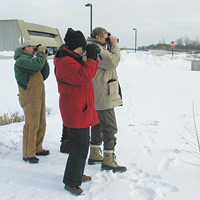|
Seeking the elusive... snipe?
Instead of spin they have lift. They interact via songs. And they come in far more than just three colors.
A total of 277 bird species has been recorded at Fermilab since surveys began in the mid-eighties. Spring and fall are peak seasons to find migratory species, while many birds call the facility home year-round. And though the birds of Fermilab may not solve the puzzles of the universe, people still come to look for them, even in the subzero temperatures of a US Midwest winter.
The annual Christmas Bird Count at Fermilab was a community effort involving members of several local birding clubs, including the DuPage Birding Club, which organized the event. Fermilab physicist Peter Kasper again joined the CBC volunteer ranks this year, as he has every year since 1987. "When I'm here in the Chicago area, I do all my birding at Fermilab," says Kasper, a lifelong bird watcher who maintains the well-known Birds of Fermilab Web site.
The Christmas Bird Count is part of a larger Audubon Society effort that takes place throughout North and South America from mid-December to early January. Tens of thousands of birders participate in the annual count, which started in 1900. The Fermilab count started in 1976. This year's total for Fermilab's 6800 acres was 2931 birds representing 49 species. Fermilab counters recorded a number of Yellow-rumped warblers, Cooper's hawks, American robins, and Mourning doves. Denis Kania (photo, far left), Area-1 leader for the Fermilab-Batavia count group, noted that while the count of robins was high, there were fewer Canada geese this year. Other less common sightings included Eastern bluebirds, Lapland longspurs, and a Lesser scaup. As for snipe?
"Our first bird of the day was a snipe," says Kania. His group found the Wilson's snipe (named after Scottish-born ornithologist Alexander Wilson) foraging in a marsh near Wilson Hall (Fermilab's main building, named after founding director Robert Wilson).
Dawn Stanton
Click here to download the pdf version of this article.







